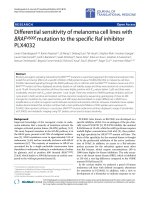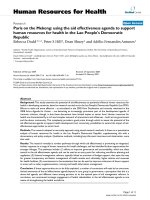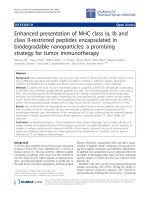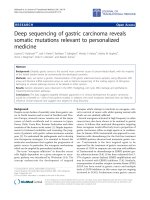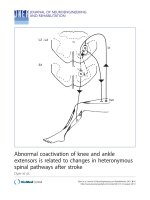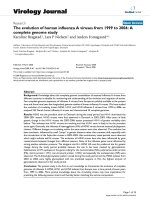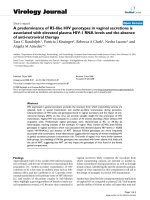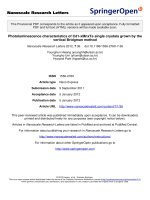Báo cáo toán học: " Electrochemical performance of NixCo1-xMoO4 (0 [less than or equal to] x [less than or equal to] 1) nanowire anodes for lithium-ion batteries" pptx
Bạn đang xem bản rút gọn của tài liệu. Xem và tải ngay bản đầy đủ của tài liệu tại đây (1.03 MB, 14 trang )
Nanoscale Research Letters
This Provisional PDF corresponds to the article as it appeared upon acceptance. Fully formatted
PDF and full text (HTML) versions will be made available soon.
Electrochemical performance of NixCo1-xMoO4 (0 [less than or equal to] x [less
than or equal to] 1) nanowire anodes for lithium-ion batteries
Nanoscale Research Letters 2012, 7:35
doi:10.1186/1556-276X-7-35
Kyung-Soo Park ()
Seung-Deok Seo ()
Hyun-Woo Shim ()
Dong-Wan Kim ()
ISSN
Article type
1556-276X
Nano Express
Submission date
2 September 2011
Acceptance date
5 January 2012
Publication date
5 January 2012
Article URL
/>
This peer-reviewed article was published immediately upon acceptance. It can be downloaded,
printed and distributed freely for any purposes (see copyright notice below).
Articles in Nanoscale Research Letters are listed in PubMed and archived at PubMed Central.
For information about publishing your research in Nanoscale Research Letters go to
/>For information about other SpringerOpen publications go to
© 2012 Park et al. ; licensee Springer.
This is an open access article distributed under the terms of the Creative Commons Attribution License ( />which permits unrestricted use, distribution, and reproduction in any medium, provided the original work is properly cited.
Electrochemical performance of NixCo1−xMoO4 (0 ≤ x ≤ 1) nanowire anodes
for lithium-ion batteries
Kyung-Soo Park1, Seung-Deok Seo1, Hyun-Woo Shim1, and Dong-Wan Kim*1
1
Department of Materials Science and Engineering, Ajou University, Suwon, 443-749, Republic
of Korea
*Corresponding author:
Email addresses:
K-SP:
S-DS:
H-WS:
D-WK:
Abstract
NixCo1−xMoO4 (0 ≤ x ≤ 1) nanowire electrodes for lithium-ion rechargeable batteries have been
synthesized via a hydrothermal method, followed by thermal post-annealing at 500°C for 2 h.
The chemical composition of the nanowires was varied, and their morphological features and
crystalline structures were characterized using field-emission scanning electron microscopy and
X-ray powder diffraction. The reversible capacity of NiMoO4 and Ni0.75Co0.25MoO4 nanowire
electrodes was larger (≈520 mA h/g after 20 cycles at a rate of 196 mA/g) than that of the other
nanowires. This enhanced electrochemical performance of NixCo1−xMoO4 nanowires with high
Ni content was ascribed to their larger surface area and efficient electron transport path
facilitated by their one-dimensional nanostructure.
Introduction
Among the types of anode materials available for rechargeable lithium-ion batteries, graphite has
been commercialized. However, because of its drawbacks, such as capacity limitations
(theoretical capacity of 372 mA h/g), initial loss of capacity, and structural deformation [1, 2],
one of the current areas of interest in lithium-ion battery research is the search for new anode
candidates that have large reversible capacities. In the past decade, transition metal oxides
(MxOy, M = Co, Ni, Cu, Fe) that can deliver a high reversible capacity by conversion reaction
mechanisms (MxOy + ne− + nLi+ ↔ xM0 + LinOy) have been considered as an alternative to
commercial graphite anodes for lithium-ion batteries [3-10].
Metal molybdates, AMoO4-type compounds (where A is a divalent metal ion), have
attracted the interest of researchers because of their electronic and magnetic properties and their
many applications, such as catalysis and photoluminescence [11-14]. Recently, CoMoO4 and
NiMoO4, synthesized with nanowire morphology by a simple hydrothermal method, were
exploited as materials for lithium-ion batteries but were only applied as cathodes [15, 16].
In this paper, we report the fabrication of NixCo1−xMoO4 (0 ≤ x ≤ 1) nanowire electrodes
by a hydrothermal method, followed by thermal post-annealing. We also demonstrate the
superior electrochemical performance of NixCo1−xMoO4 nanowires for lithium-ion battery
anodes.
Experimental details
NixCo1−xMoO4 (0 ≤ x ≤ 1) nanowires were synthesized by a simple hydrothermal method, in
which high purity Ni(NO3)2·6H2O (99.999%; Sigma-Aldrich, Saint Louis, MO, USA),
Co(NO3)2·6H2O (98%; Sigma-Aldrich, Saint Louis, MO, USA), and Na2MoO4·2H2O (99.5%;
Sigma-Aldrich, Saint Louis, MO, USA) were used as source materials, followed by postannealing at an elevated temperature. Initially, to prepare a clean solution (total cationic
concentration of 0.1 M) with a molar fraction (x) of Ni (x = 0, 0.25, 0.5, 0.75, and 1), controlled
amounts of Co- and Ni-containing reagents were dissolved in deionized water (80 mL) under
constant magnetic stirring; then, the solution was added to an aqueous solution (80 mL)
containing 0.1 M of Na2MoO4·2H2O. This resulting solution was transferred into a Teflon-lined
stainless steel autoclave, sealed, and maintained at 180°C for 8 h. After the reaction was
completed, the resulting solid products were harvested by centrifugation, washed with deionized
water and acetone several times, and then dried at 60°C for 6 h in a vacuum oven. Finally, the asprepared hydrate nanowire precursors were post-annealed at 500°C for 2 h to dehydrate them.
The morphologies and crystal structures of the prepared NixCo1−xMoO4·nH2O and
NixCo1−xMoO4 (0 ≤ x ≤ 1) nanowires were investigated using field-emission scanning electron
microscopy [FE-SEM] (10 kV; FEI NOVA, Tokyo, Japan) and X-ray powder diffraction [XRD]
(λCuKa = 1.5405 Å; Miniflex II, Rigaku, Tokyo, Japan). The thermal behavior of the as-prepared
hydrate samples was analyzed by thermogravimetric analysis [TGA] (DTG-60H, Shimadzu,
Kyoto, Japan). For TGA, the samples were heated from room temperature up to 800°C at a
heating rate of 10°C/min in air.
For the electrochemical evaluation of the NixCo1−xMoO4 (0 ≤ x ≤ 1) nanowires, positive
electrode films were cast on a Cu foil by mixing each nanowire powder (1 to 2 mg) with Super P
carbon black (MMM Carbon, Brussels, Belgium) and Kynar 2801 binder (PVdF-HFP, Arkema
Inc., King of Prussia, PA, USA) in a mass ratio of 70:15:15. The assembled Swagelok-type cells
composed of a positive electrode, negative electrode (lithium metal-foil), and separator film
(Celgard 2400, Celgard LLC, Charlotte, NC, USA) saturated with a liquid electrolyte consisting
of LiPF6 (1 M) dissolved in a solution of ethylene carbonate and dimethyl carbonate (1:1 v/v)
were cycled at voltages between 0.01 and 3.0 V using an automatic battery cycler (WBCS 3000,
WonaTech, Seoul, South Korea).
Results and discussion
Figures 1a to e show typical FE-SEM images of as-prepared NixCo1−xMoO4·nH2O precursors
with various cationic compositions. All of the samples were of nanowire morphology regardless
of their compositional differences. However, the diameters and lengths of the nanowires tended
to decrease with increasing Ni concentration. As shown in Figure 1e, the NiMoO4·nH2O
nanowires were agglomerated acutely and even formed clusters that were several microns in size.
The agglomeration of the nanowires might be due to strong attractive forces between the smallsized nanowire particles. The crystalline structures of the as-prepared NixCo1−xMoO4·nH2O
nanowires were confirmed from their XRD patterns, as seen in Figure 1f. The XRD patterns
taken from all NixCo1−xMoO4·nH2O nanowires agreed well with previously reported patterns for
CoMoO4·nH2O (JCPDS no.: 26-0477).
The dehydration process was investigated using the thermogravimetric [TG] technique;
the results of which are shown in Figure 2. The typical TG curves obtained from the
NixCo1−xMoO4·nH2O nanowires in the temperature range from 30°C to 800°C showed net weight
losses of 7% to 9% for each sample. This weight loss was mainly attributed to the evolution of
species related to water molecules, such as reversibly bound water molecules (low temperature),
water molecules forming an integral part of the crystal structure of NixCo1−xMoO4·nH2O
(medium temperature), and water molecules reversibly bound to the hydrate crystal phase (high
temperature) [14, 15]. On the basis of the TG results, the post-annealing temperature decided on
for all the hydrate samples was 500°C, at which almost all water molecules were removed
sufficiently to form NixCo1−xMoO4 nanowires.
Figures 3a to e show FE-SEM images of NixCo1−xMoO4 (0 ≤ x ≤ 1) nanowires obtained
by post-annealing the NixCo1−xMoO4·nH2O nanowire precursors at 500°C for 2 h. All postannealed samples maintained their pristine nanowire morphologies. Although a marked change
in the diameter or length of the nanowires after post-annealing was not observed, they seemed to
be agglomerated slightly and were forming bundles, which could lead to a decrease in their
surface area. In order to confirm the change in surface area that may have occurred during postannealing of NixCo1−xMoO4·nH2O nanowire precursors, the Brunauer-Emmett-Teller [BET]
(Belsorp-mini, BEL Japan Inc., Osaka, Japan) technique was carried out at liquid nitrogen
temperature. From the results presented in Table 1, it can be confirmed that the surface areas of
NixCo1−xMoO4 nanowires in all compositions were slightly decreased compared with those of the
corresponding NixCo1−xMoO4·nH2O nanowires. This was ascribed to the aggregation and growth
of the nanowires. Furthermore, it was found that the surface areas of the nanowires gradually
increased with increasing Ni concentration because of the corresponding decrease in their
diameter and length.
To investigate the crystal structures of the NixCo1−xMoO4 nanowires, their XRD patterns
were examined carefully. The XRD patterns obtained for the CoMoO4 and NiMoO4 nanowires in
Figure 3f corresponded well with their bulk materials (JCPDS nos.: 25-1434, 21-0868, 33-0948,
and 45-0142 for α-CoMoO4, β-CoMoO4, α-NiMoO4, and β-NiMoO4, respectively). However, as
can be seen in Figure 3f, both end-members had α- and β-phases corresponding to each material
together. It is known that single-phase β-CoMoO4 and α-NiMoO4 can be formed by fast cooling
and by slow cooling, respectively, to room temperature after post-annealing of their hydrates [14,
17, 18]. Meanwhile, D. Vie et al. reported that the α-CoMoO4 phase became detectable as a
minority phase after heat treatment of the amorphous solid precursor at a temperature above
700°C [17]. On the basis of these reports, we believe that the coexistence of α- and β-phases in
CoMoO4 and NiMoO4 nanowires can be attributed to the medium cooling rate (≈10°C/min to
30°C/min) applied after post-annealing or to a change of phase transition temperature with the
unique morphologies of the samples.
Among the NixCo1−xMoO4 nanowires with a medium composition, the XRD pattern of
the Ni0.25Co0.75MoO4 nanowires agreed well with that of CoMoO4. However, in contrast with that
observed for pure CoMoO4, the peaks corresponding to α-CoMoO4 became more dominant
compared with those of β-CoMoO4, indicating that relative intensities of the diffraction peaks of
the α-phase increase with Ni content [17]. In the case of the Ni0.5Co0.5MoO4 nanowires, it was
found that the XRD pattern corresponded closer with pure NiMoO4 than with pure CoMoO4
(Figure 3f). This implies that the basic crystal structure of the nanowires was transformed from
CoMoO4-related structures into NiMoO4-related structures. The XRD pattern of the
Ni0.75Co0.25MoO4 nanowires also agreed with that of pure NiMoO4. It should be noted that no
secondary phases, such as NiO and CoO, were detected in any of the XRD patterns, which
indicated that CoMoO4 and NiMoO4 formed solid solutions perfectly.
In general, most reports on the lithium reactivity of molybdates have been focused on
their application as anode materials for lithium-ion batteries because they could deliver high
reversible capacity through a conversion reaction with lithium [19-21]. Moreover, NiO and CoO
have also been known as anode materials, reacting with lithium by an equivalent mechanism
with a molybdate [3]. On the basis of such knowledge, we expected the following
electrochemical reaction mechanism of NixCo1−xMoO4 with lithium:
Ni x Co1− x MoO 4 + 8Li + + 8e− → xNi + (1 − x ) Co + Mo + 4Li 2 O
(1)
xNi + (1 − x ) Co + Mo + 4Li 2 O ↔ xNiO + (1 − x ) CoO + MoO3 + 8Li + + 8e−
(2)
To evaluate the electrochemical performance of the NixCo1−xMoO4 nanowire electrodes,
typical voltage-specific capacity curves were recorded at a current rate of C/5 (≈196 mA/g; note
that 1 C ≈ 980 mA/g on the basis of the reaction in Equation 2) in a potential window between
0.01 and 3.0 V (Figure 4). In the first discharge reaction, samples containing nickel reacted with
lithium at a lower potential region (≈0.4 V to 0.01 V) compared with the CoMoO4 nanowire
electrode (≈0.3 V to 0.01 V). Notably, the first discharge capacities for Ni0.75Co0.25MoO4 and
NiMoO4 were higher than their theoretical capacities; this might be ascribed to the formation of
the solid electrolyte interface-like organic layer. Subsequent second discharge-charge reactions
occurred reversibly on the basis of the reaction in Equation 2. These highly reversible capacities
of NixCo1−xMoO4 nanowire electrodes could be an evidence for delivering capacity by
conversion mechanism.
Figure 5 shows the specific capacity of NixCo1−xMoO4 nanowire electrodes versus the
cycle number at a current rate of C/5. When the values of x were 0, 0.25, and 0.5, the reversible
capacities of NixCo1−xMoO4 nanowire electrodes faded rapidly even during the initial cycles,
resulting in a poor reversible capacity of ≈290 mA h/g after 20 cycles. This result was attributed
to the small surface areas of the nanowire electrodes. From the BET results summarized in Table
1, it was found that their surface areas were very small compared with those of the other
nanowires, which led to a small electrode/electrolyte interface, resulting in a poor reversible
capacity. Meanwhile, the reversible capacity of the NixCo1−xMoO4 nanowire electrodes with x
values of 0.75 and 1 (≈520 mA h/g after 20 cycles) was larger than that of the previously
mentioned three nanowire electrodes because of the increased electrode/electrolyte interface that
resulted from the larger surface area of the nanowires (Table 1). In accordance with the BET
results, the electrochemical performance of the NiMoO4 nanowire electrode was expected to be
vastly superior compared with that of the Ni0.75Co0.25MoO4 nanowire electrode. However, the
electrochemical performances of both electrodes were similar, as shown in Figure 5, due to the
aggregation of the NiMoO4 nanowires. When we fabricated the positive electrode, the carbon
black that is commonly used as a conducting additive was mechanically mixed with the
nanowires as the active material. At that time, clusters formed by aggregation of the NiMoO4
nanowires could not be mixed efficiently with carbon black, which resulted in impairing their
electrochemical performance by restriction of the electronic conduction paths from each
nanowire to a current collector. In contrast, the Ni0.75Co0.25MoO4 nanowires did not form such
clusters during the synthesis process. For this reason, the Ni0.75Co0.25MoO4 nanowire electrode
could deliver a reversible capacity as high as the NiMoO4 nanowire electrode. Furthermore, the
Ni0.75Co0.25MoO4 nanowire electrode exhibited a superior coulombic efficiency of ≈95% (Figure
5).
Conclusion
In summary, we have successfully synthesized NixCo1−xMoO4 (0 ≤ x ≤ 1) nanowire
electrodes by employing a hydrothermal method to prepare hydrate nanowires, followed by postannealing of the as-prepared hydrate nanowires. Although α- and β-phases coexisted in all of the
nanowire samples, no secondary phases were detected, indicating that CoMoO4 and NiMoO4
formed perfect solid solutions. Compared with the reversible capacity (≈290 mA h/g after 20
cycles) of the NixCo1−xMoO4 nanowire electrodes with x values of 0, 0.25, and 0.5, the reversible
capacity of the nanowire electrodes containing a higher Ni content (x = 0.75 and 1) increased
more (≈520 mA h/g after 20 cycles). Despite the difference in surface area between the NiMoO4
and Ni0.75Co0.25MoO4 nanowires, the reason for the observation of their similar reversible
capacities was because of the agglomeration of NiMoO4 nanowires and the resulting restriction
of the electronic conduction paths from each nanowire to a current collector. We anticipate that
this approach will facilitate the tailoring of other electrodes based on solid solution materials, to
provide electrodes with superior electrochemical performance.
Competing interests
The authors declare that they have no competing interests.
Authors' contributions
K-SP carried out the NixCo1−xMoO4 (0 ≤ x ≤ 1) nanowire sample preparation and drafted the
manuscript. S-DS and H-WS participated in microstructural and electrochemical analyses. DWK designed the study, led the discussion of the results, and participated in writing the
manuscript. All authors read and approved the final manuscript.
Acknowledgments
This work was supported by the National Research Foundation of Korea (NRF) grant funded by
the Korea government (MEST; nos. 2010-0029617 and 2011-0005776).
References
1. Disma F, Aymard L, Dupont L, Tarascon JM: Effect of mechanical grinding on the lithium
intercalation process in graphites and soft carbons. J Electrochem Soc 1996, 143:3959.
2. Disma F, Lenain C, Beaudoin B, Aymard L, Tarascon JM: Unique effect of mechanical
milling on the lithium intercalation properties of different carbons. Solid State Ionics
1997, 98:145.
3. Poizot P, Laruelle S, Grugeon S, Dupont L, Tarascon JM: Nano-sized transition-metal oxides
as negative-electrode materials for lithium-ion batteries. Nature 2000, 407:496.
4. Taberna PL, Mitra S, Poizot P, Simon P, Tarascon JM: High rate capabilities Fe3O4-based
Cu nano-architectured electrodes for lithium-ion battery applications. Nat Mater 2006,
5:567.
5. Kim DW, Ko YD, Park JG, Kim BK: Formation of lithium-driven active/inactive
nanocomposite electrodes based on Ca3Co4O9 nanoplates. Angew Chem Int Ed 2007,
46:6654.
6. Shim HW, Jin YH, Seo SD, Lee SH, Kim DW: Highly reversible lithium storage in Bacillus
subtilis-directed porous Co3O4 nanostructures. ACS Nano 2011, 5:443.
7. Li Y, Tan B, Wu Y: Mesoporous Co3O4 nanowire arrays for lithium ion batteries with
high capacity and rate capability. Nano Lett 2008, 8:265.
8. Shim HW, Cho IS, Hong KS, Cho WI, Kim DW: Li electroactivity of iron (II) tungstate
nanorods. Nanotechnology 2010, 21:465602.
9. Lee GH, Park JG, Sung YM, Chung KY, Cho WI, Kim DW: Enhanced cycling performance
of Fe0/Fe3O4 nanocomposite electrode for lithium-ion batteries. Nanotechnology 2009,
20:295205.
10. Ko YD, Kang JG, Choi KJ, Park JG, Ahn JP, Chung KY, Nam KW, Yoon WS, Kim DW:
High rate capabilities induced by multi-phasic nanodomains in iron-substituted calcium
cobaltite electrodes. J Mater Chem 2009, 19:1829.
11. Liu J, Huang X, Li Y, Li Z: A general route to thickness-tunable multilayered sheets of
sheelite-type metal molybdate and their self-assembled films. J Mater Chem 2007,
17:2754.
12. Vilminot S, André G, Kurmoo M: Magnetic properties and magnetic structure of
CuII3MoVI2O9. Inorg Chem 2009, 48:2687.
13. Chu WG, Wang HF, Guo YJ, Zhang LN, Han ZH, Li QQ, Fan SS: Catalyst-free growth of
quasi-aligned nanorods of single cryatal Cu3Mo2O9 and their catalytic properties.
Inorg Chem 2009, 48:1243.
14. Rodriguez JA, Chaturvedi S, Hanson JC, Albornoz A, Brito JL: Electronic properties and
phase transformations in CoMoO4 and NiMoO4: XANES and time-resolved
synchrotron XRD studies. J Phys Chem B 1998, 102:1347.
15. Xiao W, Chen JS, Li CM, Xu R, Lou XW: Synthesis, characterization, and lithium
storage capability of AMoO4 (A = Ni, Co) nanorods. Chem Mater 2010, 22:746.
16. Ding Y, Wan Y, Min YL, Zhang W, Yu SH: General synthesis and phase control of metal
molybdate hydrates MMoO4•nH2O (M = Co, Ni, Mn, n = 0, 3/4, 1) nano/microcrystals
by a hydrothermal approach: magnetic, photocatalytic, and electrochemical properties.
Inorg Chem 2008, 47:7813.
17. Vie D, Martínez E, Sapiña F, Folgado JV, Beltrán A: Freeze-dried precursor-based
synthesis of nanostructured cobalt-nickel molybdates Co1-xNixMoO4. Chem Mater 2004,
16:1697.
18. Rodriguez JA, Chaturvedi S, Hanson JC, Brito JL: Reaction of H2 and H2S with CoMoO4
and NiMoO4: TPR, XANES, time-resolved XRD, and molecular-orbital studies. J Phys
Chem B 1999, 103:770.
19. Kim SS, Ogura S, Ikuta H, Uchimoto Y, Wakihara M: Reaction mechanisms of MnMoO4
for high capacity anode material of Li secondary battery. Solid State Ionics 2002,
146:249.
20. Leroux F, Goward GR, Power WP, Nazar LF: Understanding the nature of low-potential
Li uptake into high volumetric capacity molybdenum oxides. Electrochem Solid-State
Lett 1998, 1:255.
21. Sharma N, Shaju KM, Rao GVS, Chowdari BVR, Dong ZL, White TJ: Carbon-coated
nanophase CaMoO4 as anode material for Li ion batteries. Chem Mater 2004, 16:504.
Figure 1. Morphologies and crystal structures of NixCo1−xMoO4·nH2O nanowires. (a-e)
Typical FE-SEM images of as-prepared NixCo1−xMoO4·nH2O nanowire precursors with various x
values and (f) their corresponding X-ray diffraction patterns (by KS Park et al.).
Figure 2. Thermal behavior of NixCo1−xMoO4·nH2O nanowires. TG curves for as-prepared
NixCo1−xMoO4·nH2O nanowire precursors with various values of x, heating at a rate of 10°C/min
in air (by KS Park et al.).
Figure 3. Morphologies and crystal structures of NixCo1−xMoO4 nanowires. (a-e) FE-SEM
images of NixCo1−xMoO4 nanowires with various x values and (f) their corresponding X-ray
diffraction patterns. Filled circle, empty circle, filled inverted triangle, and empty inverted
triangle correspond to α-CoMoO4, β-CoMoO4, α-NiMoO4, and β-NiMoO4, respectively (by KS
Park et al.).
Figure 4. Charging-discharging curves of NixCo1−xMoO4 nanowire electrodes. Chargingdischarging curves of the NixCo1−xMoO4 nanowire electrodes with various x values at a rate of
C/5 (by KS Park et al.).
Figure 5. Electrochemical properties of NixCo1−xMoO4 nanowire electrodes. Variation of the
discharge (open circles)-charge (solid circles) specific capacity and coulombic efficiency versus
the cycle number at a rate of C/5 for the NixCo1−xMoO4 nanowire electrodes with various x
values (by KS Park et al.).
Table 1. Surface areas of prepared samples
NixCo1−xMoO4·nH2O
NixCo1−xMoO4
x value
Surface area (m2/g)
0
9.5
7.8
0.25
10.1
9.0
0.5
12.7
10.3
0.75
21.0
18.6
1
47.4
39.2
Comparison of surface areas for as-prepared NixCo1−xMoO4·nH2O and NixCo1−xMoO4 nanowires
dehydrated at 500°C for 2 h (by KS Park et al.).
Figure 1
Figure 2
Figure 3
Figure 4
Figure 5
